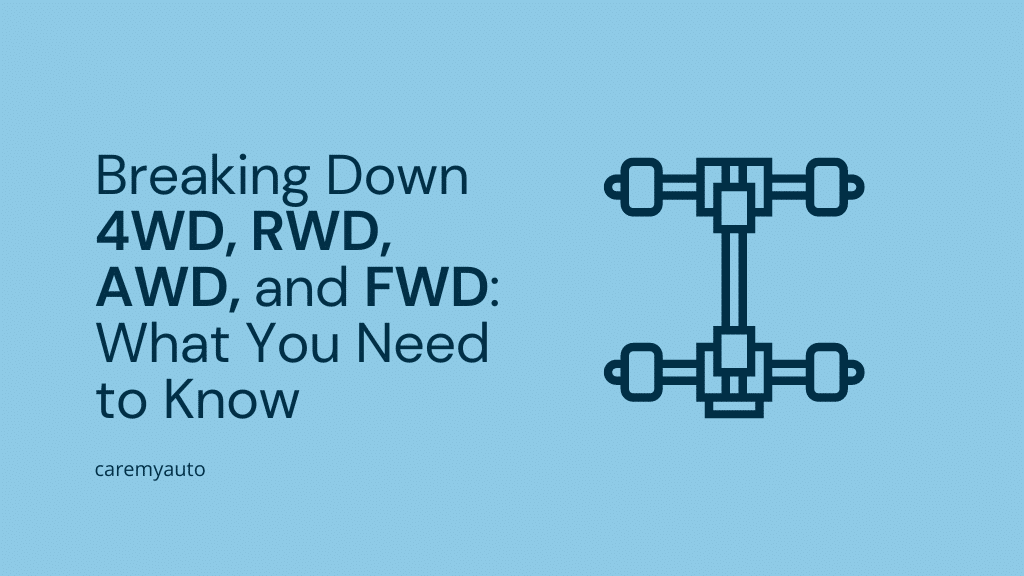When it comes to choosing a vehicle, one of the important decisions you need to make is what type of drivetrain you want. There are four main types of drivetrains: 4WD, AWD, FWD, and RWD. Each has its own set of advantages and disadvantages. It’s important to understand the differences between them to make an informed decision.
In this post, we’ll compare them to help you make an informed decision.
4WD (Four-Wheel Drive)
4WD is a system that distributes power to all four wheels of the vehicle, providing maximum traction and control. It’s ideal for off-road situations or when driving in extreme weather conditions, such as snow or mud, and is used in off-road vehicles such as trucks, and SUVs, where the ability to handle rough terrain and challenging conditions is essential.
The 4WD system can be engaged manually or automatically, and it typically includes a low-range gear for increased torque. The downside to 4WD is that it can decrease fuel efficiency, and it’s not recommended for use on dry pavement.
Pros:
- Excellent traction and control in off-road conditions.
- Provides maximum power to all four wheels.
- Can be engaged manually or automatically.
Cons:
- Adds weight and complexity to the vehicle.
- Reduced fuel efficiency.
- Not ideal for everyday driving on smooth surfaces.
AWD (All-Wheel Drive):
AWD is similar to 4WD in that it distributes power to all four wheels but in a more balanced and controlled way. However, while 4WD is engaged manually, AWD is always on. This makes it a good choice for all weather conditions, including dry pavement, as AWD can automatically adjust power distribution to each wheel based on driving conditions, ensuring optimal traction and stability.
AWD is often found in crossover SUVs and luxury vehicles. The downside to AWD is that it can be more expensive than other drivetrains, and it can decrease fuel efficiency.
Pros:
- Balanced power distribution for improved traction and stability.
- Improved handling in wet and slippery conditions.
- Better fuel efficiency than 4WD.
Cons:
- Not as capable in off-road conditions as 4WD.
- Adds weight and complexity to the vehicle.
- More expensive than FWD or RWD.
FWD (Front-Wheel Drive):
FWD is a system where power is delivered to the vehicle’s front wheels. It’s a popular choice for everyday vehicles and is often found in sedans and compact cars, as it provides good fuel efficiency and handling. FWD provides good traction in most driving conditions and is generally easy to control.
The downside to FWD is that it can cause understeer in certain situations, such as when accelerating too quickly or when driving in wet or icy conditions.
Pros:
- Good traction in most driving conditions.
- Affordable and efficient.
- Generally easy to control.
Cons:
- Not as capable in extreme off-road or snow conditions.
- May tend to understeer.
- Less balanced weight distribution than RWD.
RWD (Rear-Wheel Drive):
RWD is a system where power is delivered to the rear wheels of the vehicle. It is commonly used in sports cars and high-performance vehicles, where handling and acceleration are top priorities. RWD provides a more balanced weight distribution than FWD, which can improve handling in certain situations.
The downside to RWD is that it can be difficult to control in wet or icy conditions, and it’s not as fuel-efficient as FWD.
Pros:
- Excellent handling and acceleration.
- Balanced weight distribution.
- Generally, more fun to drive than FWD.
Cons:
- Not as efficient as FWD.
- Can be difficult to control in wet or slippery conditions.
- Not as practical for everyday driving as FWD or AWD.
Conclusion
Each drivetrain system has its unique advantages and disadvantages, and the choice depends on your needs and preferences. For those who prioritize off-road capability, 4WD is the way to go. For those who want a balance between off-road capability and everyday drivability, AWD is a good choice. FWD is a practical and efficient option for everyday driving, while RWD is for those who value handling and acceleration above all else. Whatever the choice, understanding the differences between these drivetrains is essential for making an informed decision. Keep these factors in mind when making your decision, and you’ll be sure to find the right vehicle for you.

